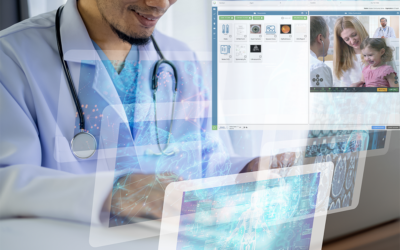Telemedicine has a reputation for being a beneficial integrated service that can lower health care costs, improve facility efficiencies and offer patients improved access to quality care. It’s a complex solution that can benefit all ages; offering assistance through the immediate stages of life and beyond. Specifically, telemedicine and telehealth solutions have an opportunity to enhance care throughout the duration of pregnancy and pediatric care.
As a part of our Telemedicine in life stages series, this article will dive into gestation and pediatrics and what type of role telehealth plays in the care continuum. Let’s take a closer look at how telemedicine can benefit a pregnant woman during her prenatal care, and how telehealth can play a key role in pediatrics by increasing access to specialty care for children.
Pregnancy: Checkups, specialty services and more
As pregnancy is an amazing time for new mothers, it also comes with various symptoms and potential challenges that can make the experience stressful or more difficult. Traveling frequently to and from appointments and finding a specialty doctor are two common barriers that make pregnancy harder for mothers-to-be. Technology available for prenatal care can help women overcome such issues, however.
According to the Office on Women’s Health of the U.S. Department of Health and Human Services, routine check-ups occur once each month during weeks four through 28, twice a month during weeks 28 through 36 and once weekly for weeks 36 up until birth. Women going through high-risk pregnancies tend to see their doctors even more.
 Telemedicine allows pregnant women to speak with specialists in times of need.
Telemedicine allows pregnant women to speak with specialists in times of need.For some women, making all of these appointments can seem impossible; there may be barriers to transportation for those who live in rural areas, or the simple fact that there’s limited time to take off of work to make it to the doctor’s office. Video conferencing and remote clinical assessment via telemedicine can eliminate such challenges that keep pregnant women from receiving the care they need. It allows the patient and doctor to connect face-to-face via video to discuss the current state of gestation and address any potential issues or concerns through clinical assessment and/or video counseling.
Another benefit that comes with avoiding trips to the hospital or doctor’s office is the elimination of sitting in the waiting room. According to the American Pregnancy Association, the immune system weakens during pregnancy, making women more susceptible to getting sick while carrying. Because there are usually sick patients waiting to get treated, pregnant women can avoid the risk altogether with telemedicine appointments.
Since high-risk pregnancies generally involve seeing a specialist for advanced treatment, women with limited access to care may find it more difficult to reach a facility that offers this type of specialization. Telemedicine and remote video conferencing allow women to connect with specialists in emergency situations, providing assistance that can save the lives of both the expectant mother and baby.
Pediatrics: Specialization and care from a distance
Because they’re still in the process of building up their immunity, infants and toddlers are at greater risk for illness and viruses, according to the Cleveland Clinic. When you make telemedicine available to these young children, mothers gain peace of mind knowing there’s another option when it comes to emergency care. The need to sit in the waiting room is eliminated as well, saving time, energy and worry that the baby may catch something from another sick individual.
Telemedicine and telehealth solutions play a vital role in pediatric specialization as well. Pediatric cardiology, radiology and pathology are among some of the care models that can utilize telemedicine and video conferencing to connect young patients with their doctors when there’s a barrier to care access in rural communities or for parents who cannot take time off work to make it to dozens of specialty care and follow up appointments. The future of healthcare is focused around value-based care, and telemedicine can ensure parents and young children alike feel confident in the overall quality of general assistance and specialization.
Telemedicine provides a solution to some of the most common challenges faced during pregnancy as well as potential barriers that keep infants, toddlers and young children from receiving the quality care and specialty services they need. Check back next time for the second edition in the Telemedicine in life stages series about how telehealth solutions impact adolescents and young adults.






